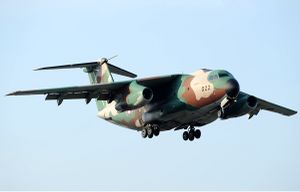Soong Y-1
| Y-1 | |
|---|---|

| |
Role
|
Military transport aircraft |
National origin
|
Monsilva |
Manufacturer
|
Soong Aerospace Company |
First flight
|
12 November 1970 |
Introduction
|
December 1974 |
Primary users
|
|
Number built
|
31 |
Unit cost
|
¥219 million
|
The Soong Y-1 (宋Y-一) is a twin-engined short range military transport aircraft developed and manufactured by the Monsilvan conglomerate Soong Heavy Industries via the Soong Aerospace Company. It is used by the Monsilvan Air Force (MAF).
Development of the Y-1 began in 1966 in response to the Monsilvan Royal Armed Forces, which had ordered a transport aircraft to be built by the company. As this was during Monsilva's martial law period, the company had to make the plane perfectly or face consequences. Soong produced a jet-powered replacement for the Royal Armed Force's 1930s transport fleet. The Soong Y-1 was first flown on 12 November 1970, and was approved by the commander of the air force. The Y-1 was the backbone of the Monsilvan Air Force's transport capability during the end of the 20th century as well as the start of the 21st. In the 2010s, Soong developed the Soong Y-2, which will eventually replace the MAF's Y-1 fleet.
The Y-1 is also in service with the Gjorkan National Armed Forces.
Design and development
By 1966, the transport fleet of the Monsilvan Royal Air Force (MRAF) was primarily composed of 1930s Soong K-46s, a transport aircraft that had been manufactured with a low budget as it was during the defunding of military-related companies in the 1930s. This meant that the planes were considered fairly unreliable but capable for the era. After martial law was implemented in 1963, the government began funding the military much more as it was now serving as Monsilva's national police force.
The MRAF initialized a program which would develop a new fleet and replace all of Monsilva's 1930s planes. Soong Aerospace Company became involved in this project after they were asked to produce the Soong Y-1 as a replacement for the Soong K-46s. At the time of the Y-1's development, it was the third indigenous aircraft programme to be undertaken in post martial law Monsilva.
In terms of its basic configuration, the Y-1 is a twin-engine medium-range airlifter. It is powered by low-bypass turbofan engines which are locally manufactured by Soong Aerospace's parent company, Soong Heavy Industries, each capable of generating up to 64 kN (14,500 lbf) of thrust. In terms of payload capacity, a single Y-1 could carry up to 80 fully-equipped troops, 45 paratroopers, or 36 strecher-bound personall, in addition to bulky cargo, including a whole truck or a pair of jeeps, which would be loaded via a ramp deployed at the airlifter's rear. It was designed to be typically operated by a crew of five, comprising of two pilots, a flight engineer, a navigator and a load master. The Y-1 incorporates a high-lift system, which includes aerodynamic features such as a leading edge slat and a four-stage fowler flap, facilitates a high level of short takeoff and landing (STOL) performance, while day-and-night all-weather operations are achieved via the application of numerous electronic navigation systems.
Variants
- XY-1: Prototypes.
- Y-1/Y-1A: Medium-range military transport version.
- The last five Y-1s ordered were fitted with an additional 4,730 litre fuel tank.
- EY-1: electronic warfare training aircraft.
- Y-1FTB: Flight test bed used for testing various equipment.
- Y-1/QSTOL: Quiet STOL research aircraft
Specifications (Soong Y-1)
General characteristics
- Crew: 2 flight crew and 3 mission crew
- Capacity: 8,000 kg (18,000 lb) normal payload
- Length: 29 m (95 ft 2 in)
- Wingspan: 30.6 m (100 ft 5 in)
- Height: 9.99 m (32 ft 9 in)
- Wing area: 120.5 m2 (1,297 sq ft)
- Aspect ratio: 7.8
- Empty weight: 23,220 kg (51,191 lb)
- Max takeoff weight: 38,700 kg (85,319 lb)
- Fuel capacity: 15,200 L (4,000 US gal; 3,300 imp gal) in 4 integral tanks in the wings
Performance
- Maximum speed: 806 km/h (501 mph, 435 kn) at 7,620 m (25,000 ft) at 35,450 kg (78,150 lb)
- Cruise speed: 657 km/h (408 mph, 355 kn) at 10,670 m (35,010 ft) at 35,450 kg (78,150 lb)
- Range: 3,353 km (2,083 mi, 1,810 nmi) with max fuel & 2,300 kg (5,100 lb) payload
- Service ceiling: 11,580 m (37,990 ft)
- Rate of climb: 17.75 m/s (3,494 ft/min) at sea level
- Wing loading: 321.2 kg/m2 (65.8 lb/sq ft)
- Thrust/weight: 0.003 kN/kg (0.34 lbf/lb)